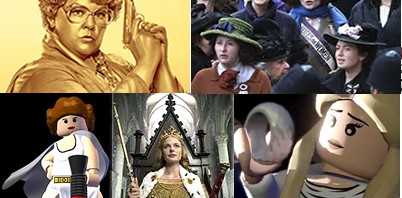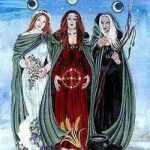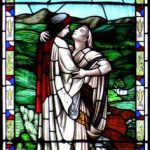We’re in every home, we’re half the human race…
– Maud Watts, Suffragette
Two years ago, I wrote a blog I called Women Centre Stage. It was inspired by my girls, who had just started school, and had discovered that by using the open world or free play mode when playing Lego Lord of The Rings and Lego Star Wars, they could create their own stories, with all the female characters in the centre of the story. Each time they get a new game, they spend time tailoring it to reflect their lives – lives in which girls have the main roles.
It is 2015, but incredibly, there is a proposal to drop feminism from the A-level politics syllabus. In her column, Bridget Christie wonders why the new Creative United Kingdom passport, celebrating 500 years of British talent, only included two women yet seven men. And, why an Israeli newspaper digitally removed Angela Merkel and Ann Hidalogo from a photo. Women are literally being airbrushed from history.
I am a female computer scientist and on a recent IT course I taught, there were three female students to 40+ male ones. This ratio is a lot worse than when I was an undergraduate and, I didn’t really notice until my girls asked me at breakfast: How many girls do you teach, mummy? …Where are the rest?
Where are the girls?
The other week, we attended Sung Eucharist at St Paul’s Cathedral and my girls asked: Where are the girls in the choir? Where are the female statues? Where are the girls’ stories? I thought about my childhood growing up in the Church of England. When I was about 12 years old, female lay preachers were still novel and I was one of many girl choristers. And, so it was easier to believe that it only a matter of time before things would change further. However, when I looked at the one woman standing at the front in St Paul’s the other week, amongst all those men, I felt like nothing had progressed at all.
It reminded me of Joseph Campbell’s monomyth. Women only appear in it as temptresses or goddesses, and they only have support roles. We don’t hear their stories or their trials and tribulations. Instead they are silent. They are faithful and they endure like Penelope. Odysseus is off living his life seeking glory whilst Penelope is stuck at home as a desperate housewife.
This traditional supporting and enduring journey of our heroine is described in three steps on Ribbonfarm:
- The heroine is yet undeveloped.
- Her worth and her ability to persevere is threatened.
- She endures gracefully and the more she suffers, the moredignified she becomes, until her dignity gives her strength and she regains her worthiness.
When I read Storytelling and Mythmaking by Frank McConnell, I loved that he said that stories save our lives, and that he used films as well as the classics to illustrate myths. However, he only briefly mentioned women and only enduring women in support roles. The discussion focused on male heroes and anti-heroes and their journeys. An alien visiting earth would think that there had been no movies made with strong female characters during that time span – none what so ever.
Not just heroes with boobs
In contrast to the traditional heroine’s quest, the hero’s quest or journey shows that the 1) hero is uncomfortable in the world, and 2) sees a call to adventure, 3) but refuses until life is unbearable and forces changes 4) the hero meets a mentor, then 5) the hero crosses the threshold of no return 6) is tested, meets allies and enemies 7) ready for the major approach or challenge 8) then the hero undergoes an ordeal and faces death and/or a greatest fear, until 9) there is reward, but still the hero is not out of danger – all can still be lost as the hero begins the 10) journey home, only to near get to home and is 11) tested once more, until all ambivalence about this quest has gone 12) the hero sets about transforming the world as the hero has been transformed.
On the fangirl blog series: the heroine’s journey, they look at what a feminine parallel to the hero’s quest would look like. Campbell looked backwards for his model so fangirl blog looks forwards to identify strong female stories who are not just heroes with boobs. They have feminine concerns, such as whether to have children or not, and they do not necessarily get a happy ending. Is this a reflection of our times?
Ribbonfarm defines the modern heroine’s journey in these three steps:
- The heroine is confused.
- Her value and dignity are threatened, and her ability to defend this value is tested.
- She proves her value by either transcending or invalidating the test and then she redefines what her worthiness means.
The reluctant Suffragette
Suffragette follows a group of women fighting for the right to vote. The lead character, Maud Watts, follows each step of the hero’s quest within the modern heroine’s journey. She is reluctantly called and refuses the call, until there is no alternative and she becomes convinced that change is the only way forward. She pays a high price for her value, but is able to save another young girl from living the life she has lived. Maud Watts’s goal is to find a different way to live this life, which is ultimately what she does. It is a poignant and moving film.
Suffragette’s writer, Abi Morgan said that many male actors turned down Suffragette because the male roles were only supporting roles. It also took ten years to get the funding to get it made because it has a predominantly female cast and no romance – not a major box office draw? It is only aimed at half the population.
Incidently, I read a theory (for which I can’t, alas, find original references) that the reason only the women over 30 were given the vote in the UK in 1918, was because so many young men had been killed in World War I, Parliament didn’t want a female majority making decisions on how the country was to be run.
Would the UK and the rest of the world look different today if Parliament had decided that a female majority was a good thing?
Spy v Spectre
Spy movie also follows a heroine’s quest of answering the call, transcending her circumstances, and creating new ones for herself whilst becoming happy in the process of self-actualisation. It has plenty of great female characters too. The most successful spy, Karen Walker, is a woman, as is the boss, Elaine Crocker, and the baddie, Rayna Boyanov, who inherits the business from her dad. No one feels the need to explain or justify these women’s place – it is the way of the world – a balanced world of equal opportunity. A lot of the movie is played for laughs so it is very funny whilst turning the spy formula on its head. The deskbound agent grow into her brilliance in the field and at the end of the movie she turns down the hot guy to have a girl’s night, because she knows what is important. She values her friends and support network.
Spy has ruined all other spy movies for me because it was so good and like my girls, I love watching women come into their own on the big screen. It is much more satisfying. It resonates with us. Spy is particularly brilliant as the main character is a 40-year old woman who she doesn’t need to be anything else but herself in order to achieve success. Susan Cooper embodies a new fabulous heroine with a great message.
After Spy, I watched Spectre and in comparison it seemed very old-fashioned and formulaic, and no fun at all. Bond shoots people and takes parts in fantastically elaborate stunts. He is a maverick who saves a corrupt world whilst getting revenge. He is of course supported by women who endure until they need saving and who find him irresistible. Yawn! The women are only there to boost his ego.
I eagerly await the Spy sequel. Move over Bond, Susan Cooper has arrived.







8 comments